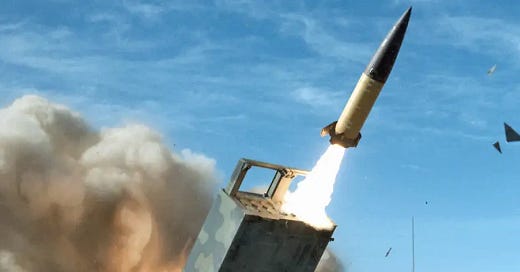The White House Authorized Ukraine to Fire U.S. Munitions At Targets Inside Russia. Then Someone Leaked The News.
The leak could give Russian forces time to redeploy.
Reportedly alarmed by the thousands of North Korean troops arriving along the front line of Russia’s 33-month wider war on Ukraine, U.S. president Joe Biden has belatedly authorized Ukraine to strike targets inside Russia with its best U.S.-made Army Tactical Missile Systems rockets.
Maddeningly, someone in the Biden administration leaked the decision to The New York Times, potentially giving the Russians time to redeploy their most vulnerable forces—and get them safely beyond the reach of the 190-mile-range ATACMS.
The new authorization reportedly only applies to Kursk Oblast in western Russia. A strong Ukrainian force invaded Kursk back in August, and still occupies around 250-square miles of the oblast. On Nov. 7, 50,000 Russian troops backed by thousands of North Koreans launched a counteroffensive in Kursk—one that, so far, has cost the Russians hundreds if not thousands of casualties without significantly moving the front line.
The GPS- and inertially-guided ATACMS, some models packing 950 grenade-size submunitions, have proved devastating against large concentrations of Russians. The Ukrainian army is adept at spotting mass gatherings of Russian troops—with drones, usually—and then striking them with ATACMS or smaller M30/31 rockets fired by wheeled High-Mobility Artillery Rocket Systems.
But in leaking the new authorization, U.S. officials could help the Russians to mitigate the new rocket risk in Kursk. Note Ukrainian president Volodymyr Zelensky’s displeasure in the hours following the Times’ story. “There’s a lot of talk in the media about us receiving permission for respective actions,” Zelensky wrote. “But strikes are not carried out with words. Such things are not announced. Missiles will speak for themselves.”
And recall what happened in August, amid what proved to be false rumors that Biden was then about to loosen restrictions on ATACMS strikes inside Russia. The Russian air force’s 47th Guards Bomber Aviation Regiment had parked dozens of Sukhoi Su-34 fighters—out of roughly 100 in service—in the open at Voronezh Malshevo air base in southern Russia, a hundred miles from the border with Ukraine.
Voronezh Malshevo is reasonably well-defended, so the Ukrainians pleaded for permission to fire ATACMS at the base, potentially dealing a decisive blow against the Russian air force. The ATACMs are almost impossible to intercept.
But Biden said no. “Our policy has not changed,” Jake Sullivan, Biden’s national security advisor, told reporters at the time. For the next three months, Ukraine would only be allowed to fire ATACMS at targets in Russian-occupied Ukraine.
The Russians observed the heated diplomacy regarding ATACMS—and, rather than take any chances, made a rare proactive decision to pull their Su-34s from Voronezh Malshevo and other border airfields. Even if the ATACMS authorization had come then, it might’ve been too late to inflict maximal damage on the 47th Guards Bomber Aviation Regiment.
The prolonged negotiations over the ATACMS authorization—combined with leaks to the media—have provided Russia ample advance warning of any coming bombardment.
Read more:
Why Do Russian Marines Keep Riding Their Armored Vehicles Straight Into Ukrainian Defenses?
On Oct. 15, Russian marines from the 810th Naval Infantry Brigade counterattacked the right flank of the 250-square-mile salient that Ukrainian troops carved out of western Russia’s Kursk Oblast starting in early August.






